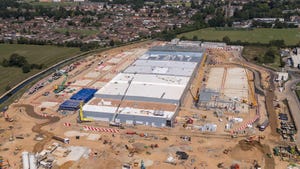
Insight and analysis on the data center space from industry thought leaders.
Conducting Your “Power Due Diligence” When Acquiring Existing Data Centers
The due diligence needed to acquire existing information technology assets involves a lot of factors, writes Mark Townsend of GE Critical Power. Data center power is part of that due diligence, and goes far beyond assessing the age of the backup generator or power protection and distribution equipment.
March 10, 2015

Mark Townsend, senior field application engineer, at GE’s Critical Power business, works with data center customers to build and sustain massive data and network capacity with reliable and energy-efficient power.
There are a lot of approaches to expanding data center capacity – build new, upgrade existing infrastructure, establish colocation facilities. Each has its pros and cons. But larger companies, whether large data users or data services providers, often have the opportunity to acquire the data center assets of another firm. Perhaps the company is expanding through acquisition or is making a strategic move to expand to another market and sees an acquisition as a quick expansion path.
The due diligence needed to acquire existing information technology assets – equipment, facilities, power generation and protection platforms – involves a lot of factors. These range from assessing the remaining life-cycle value of capital equipment, or the ratio of current server processing capacity per square foot, to the operational expenditures (OpEx) and related energy efficiency of server, cooling and power protection systems.
Data center power – from power distribution to power protection – is part of that due diligence, and goes far beyond just assessing the age of the backup generator or power protection and distribution equipment.
What Are the Capacity Needs?
The first question in evaluating the power factors of a data center under consideration is the immediate goals and requirements for the operation. For example, if the rationale for acquiring an existing facility is as an interim, supplemental data center operating at less than capacity, then using “best conventional” power technologies, acquired at the right price, can make sense. OpEx costs for older equipment should also be a factor in this cost analysis.
Interim Upgrade
With an interim-use view of the facility, inventorying the age, energy efficiency and maintenance schedule of power equipment, such as the batteries in uninterruptible power supply (UPS) units, should be factored into the purchase evaluation. A potential buyer of a data center certainly should also ask for the uptime performance and maintenance records from the facility.
Energy efficiency and the related OpEx costs of UPS units might be satisfactory for a short time if operating at traditional power conversion levels of 92 to 94 percent is acceptable. This isn’t a long-term strategy, but may suit the immediate need for data center capacity. An analysis of power consumption records against comparable facilities as measured by watts per square foot can be an evaluation metric. So can measuring the kilowatt-hours of energy per cubic feet of cooling water when using a chiller plant for cooling.
State-of-Art Facility
Conversely, the criteria for acquiring a current data center might be to have a robust capacity operating at high efficiency power levels. If so, then factors such as the age of the power assets, with higher maintenance costs and lower power efficiency, may influence this decision. If power efficiency and lower OpEx costs are a factor, then the extent to which newer high-efficiency power systems are deployed is a key factor. Newer multi-mode UPS units, operating at 97 percent efficiency in double conversion mode, and 99 percent efficiency in multi-mode, present immediate energy cost savings that can add up to millions of dollars in OpEx costs over ten years.
Power efficiency also plays a role for facilities employing newer less power-hungry systems, such as free air, evaporative cooling or even liquid cooled or liquid immersed servers, versus traditional air conditioning approaches.
Charting an Upgrade Path
A comprehensive and thorough power assessment offers insight in the final buy-or-pass decision in acquiring a third-party data center. That same assessment also offers a good blueprint for further upgrades. For example, an older power system might be a logical choice as a near-term interim strategy. This same assessment gives new owners a clear picture of the investment and ramp-up schedule to upgrade to more up-to-date power-efficient, lower OpEx power distribution and protection infrastructure.
Hidden Service Agreement Risks
For data center service providers, one power consideration often overlooked is the impact on power-related service interruption on service level agreements (SLAs). The overall reliability of the power structure has a direct impact on uptime and system recovery, and the SLA payouts a data center provider might have to pay.
Assessments in this scenario should include a review of power protection redundancy and the age of UPS units as well as related battery back-up systems. Data center service providers should also assess whether the current technology can support the SLA contractual requirements and marketing claims of an Uptime Institute Tier III or Tier IV rating. For example, while an operational data center may initially be rated at Tier IV, data center providers should determine if an aging infrastructure or batteries nearing end of life, for example, still support the Tier IV status and quality claims made in marketing promotions and SLA agreements.
Location, Location, Location
An easily overlooked power consideration is the location of the data center facility. Certainly power availability is a factor, but more important is the quality of the power from the local utility. A more urban setting with higher peak demands may affect the quality of the power and the reliance on UPS batteries and generator OpEx costs. A small initial investment in a power quality audit before the purchase will indicate the quality of local power, as would the public records of utility power outages or brownouts.
A more comprehensive look at the state of a data center’s power assets, operations and efficiencies can turn up some significant decision points in helping make that go/no-go decision about existing data center assets, as well as highlighting hidden issues and opportunities that lie ahead.
Industry Perspectives is a content channel at Data Center Knowledge highlighting thought leadership in the data center arena. See our guidelines and submission processfor information on participating. View previously published Industry Perspectives in our Knowledge Library.
About the Author
You May Also Like




.jpg?width=300&auto=webp&quality=80&disable=upscale)




